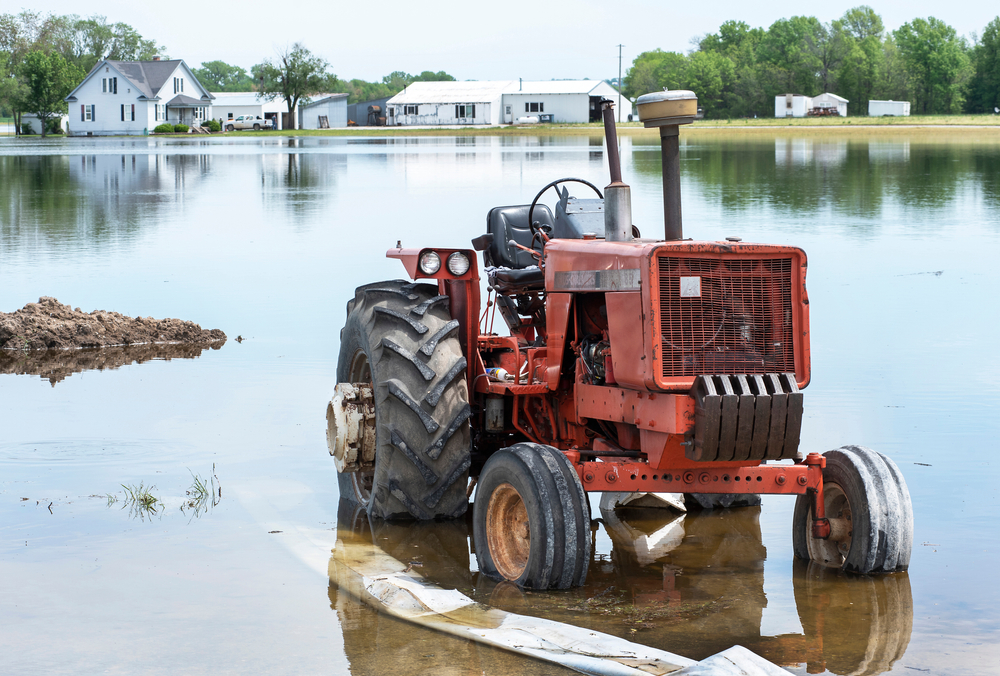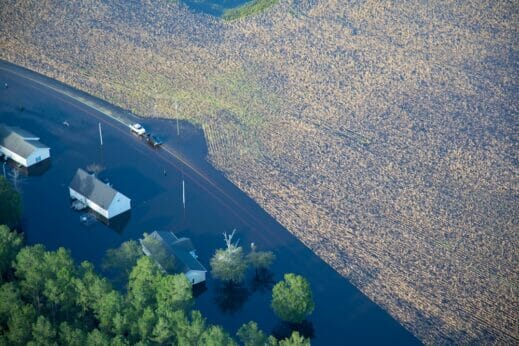As hurricanes get stronger, storm surges are bringing saltwater to farmland—and leaving salt there once waters evaporate.

Eerily empty, abandoned fields stretch across the coast of the southeast United States, replacing once sprawling fields of golden wheat, corn and soybeans.
For centuries, farmers have favored the rich soil of coastal areas during the growing season. “It’s very fertile soil, especially in some areas that are called the ‘black lands.’ These are really deep organic soils that formed on the coast over millennia,” says Michael Gavazzi, coordinator of the USDA Southeast Climate Hub coordinator and natural resource specialist.
It’s a different story when the floods come in. Hurricanes and tropical storms bring torrential rain and powerful winds that cause storm surges—abnormally large waves that can tower up to 25 feet in height. The aftermath of such disasters is devastating. Crop damage and equipment loss can rack up to thousands of dollars for farmers, even with insurance. The spread of invasive species hinders future growing seasons of certain crops. And most of all, flooding risks long-term consequences to soil health and the geological makeup of farms that could force farmers to permanently abandon their land.
Take, for instance, 2018’s Hurricane Florence. The slow-moving Category 4 giant ravaged southeast coasts, with wind gusts as high as 100 miles per hour, rainfall that exceeded 10 inches in most coastal regions (Swansboro reported 34 inches of total rainfall) and $24 billion in damages—more than Category 5 Hurricane Matthew and Category 4 Hurricane Floyd combined. The initial $1.1-billion damage cost calculation was conservative, and it didn’t account for damages from soil salinization. Even worse, climate scientists say that rainfall estimations were worsened by climate change, an indication that future storms could follow similar patterns.
The storm rocked North Carolina’s agricultural industry to its core. Five of six top agricultural counties of the state were in the most storm-vulnerable areas. Most eastern farmers’ fields were obliterated; the storm came right before peak harvest season for tobacco, corn and cotton. Crop insurance didn’t cover all the damages incurred, especially not the long-term costs.
“Fresh water [non-saline] flooding from intense rainfall events can [have] short- and long-term consequences,” says Gavazzi, “but the land will usually recover.” However, ocean-driven storm surge flooding is saltwater, and crop productivity can be negatively impacted. Repeated flooding can permanently reduce forest, range and agricultural production of these coastal areas.
Soil salinization occurs when seawater from floods eventually evaporates but leaves behind its salt content, which accumulates over years in the soil. With enough flooding, the soil on farms could become so salinized that crops can no longer be grown on that land.
More often known as saltwater intrusion, soil salinization can also impact local water quality; the salt eventually makes contact with freshwater aquifers, thus salinizing them. Many local communities source water from wells that draw from these aquifers. Aquifer salinization forces these communities to drill new wells deeper and further inland, which further depletes underground freshwater and creates a self-enforcing loop.
This process isn’t immediately noticeable: One hurricane season isn’t enough for farmers to see the effects. But several years later, farmland productivity starts to plummet. Crop yields never return to previous rates, and there is only so much farmland owners can do to rid the salt before another hurricane comes along.
The issue, although having long been a concern among agronomists, started to rapidly proliferate in the past couple of years, as hurricanes and natural disasters become more frequent and more severe as a result of human-caused climate change. While not solely to blame for extreme weather, scientists agree that the burning of fossil fuels is supercharging normal weather patterns.. “It seems like it’s become more of an important issue in the last five to 10 years as [soil salinization] started to impact more land,” says Gavazzi.
“What they can do is hope for rain. Rain before a storm surge can fill up the soil pore space and prevent saltwater from entering the soil. Additional rain that occurs with a hurricane can also flush the standing saltwater off the land and kind of return it back to its previous non-saline state.”

2018’s Hurricane Florence obliterated many farms in North Carolina’s coastal areas. (Photo: Shutterstock)
As sea level increases due to climate change, the difference between ocean water levels and soil elevation is decreasing, making post-storm water runoff more difficult. Although the rain can eventually help flush out salt content in soil, long-term accumulation of salt far exceeds what natural precipitation can remove. Small farmer owners can also use water to flush out salt on their own, but this solution is far from viable for medium to large farm owners.
Another issue, which is essential to mitigating damage, is that salinization is harder to spot than expected. “[It’s] not always obvious on the surface,” explains Gavazzi. “Sometimes, it washes away, but the salinity of the soil can be increasing … There’s noticeable declines in productivity with that, but it’s kind of quiet after the event.” Farmers not equipped with the proper resources and knowledge to understand this are at particularly high risk of losing farmland.
“We’ve talked to some farmers that have constructed dikes to try to keep the water out,” he says. But infrastructure also comes with certain drawbacks. “Dikes are good for keeping out some flooding, but when water gets behind them, they hold that water and it also changes the natural landscape [of the area].”
To support coastal agriculture, the USDA, in partnership with regional and national organizations, provides financial and technical assistance to farmers in order to aid during recovery, post natural disaster. Research studies on future mitigation and resilience strategies are also well underway at universities. A research group formed jointly by scientists from Duke University and the University of Virginia recently published their findings mapping saltwater intrusion across the eastern coast in high-profile journal Nature. They found that between 2011 to 2017, “salty patches”, an indication of saltwater intrusion, have doubled in frequency across Delaware and in parts of Virginia and Maryland. Up to 93 percent of the farmlands analyzed were shown to be in proximity to the salinized areas. The economic implications of such changes were estimated to run as high as $107.50 million annually.
Other research efforts that revolve around salt-tolerant crop development and cover crop planting practices are beginning to gain traction among farmers. Michelle Lovejoy, a climate resilience manager at the Environmental Defense Fund, says that today’s farmers are more willing to adapt such mitigation practices.
“We are starting to see that shift as the next generation starts to take over the farm and as farmers are noticing ‘I’m getting more wet years,’” says Lovejoy.
Lovejoy emphasizes that the impacts of flood damage reverberate throughout state-wide communities, as well as local agricultural ones. When flooding disrupts crop production, especially of staple crops such as corn, wheat or potatoes, grocery stores and farmers’ markets take a hit.
She explains that, particularly in states that are responsible for producing large amounts of a staple crop, flooding can result in supply chain collapses. Food disappears off store shelves and already food-insecure communities are left to grapple with devastating food shortages.
“That’s where, collectively as a nation, we need to make sure there’s redundancy in the system, but we, as a society, have made decisions historically that looked at efficiencies and cost,” says Lovejoy, referring to practices that ensure no singular agricultural community is responsible for producing the majority of a crop supply for the rest of the country.
She draws a comparison to a similar occurrence during the pandemic. “During [COVID-19] when we watched the supply chains collapse, we made decisions that said, ‘We don’t need those redundancies,’” says Lovejoy. “But now we’re realizing [that] part of resilience is having redundancies in the system. That’s a local level conversation that needs to happen.”
You are actually talking about two different processes in this article. Salt water inundation (from the surface, i.e.. storms) and salt water intrusion (from below), saltwater pushing up through the ground and into aquafers. Generally storms aren’t as bad since there’s usually rain to flush the salt away. Not so much with intrusion.
The last 3 paragraphs are particularly relevant as we have a window of opportunity now to re-localize farming to serve the needs of local communities and regional hubs, ensuring food security with more diversified crops, especially indigenous crops and shorter supply chains. Our profit-motive has dangerously skewed the game to just-in-time, six-continent supply chains, sparing no innovation and squeezing every last drop of productivity out of agricultural practices, leaving very little wriggle room for shocks and leaving the entire system vulnerable to disruption, with redundancies ditched in favour of more efficiency.
The growing recognition and adoption of research efforts focused on salt-tolerant crop development and cover crop planting practices among farmers are promising developments. Michelle Lovejoy, the climate resilience manager at the Environmental Defense Fund, highlights the increasing willingness of today’s farmers to embrace such mitigation practices.
In actuality, this article discusses two distinct procedures. Both saltwater intrusion—which comes from below—and inundation—which comes from the surface, such as storms—come up through the earth and settle into aquafers. Since rain normally washes the salt away, storms are generally not as terrible. With incursion, not so much.
My need for the subject matter is so great that I am often searching for more knowledge. I look forward to the chance to evaluate your written work after that. We sincerely appreciate your wonderful sharing contribution.